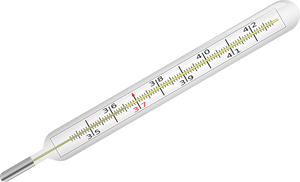
PUMPA - SMART LEARNING
எங்கள் ஆசிரியர்களுடன் 1-ஆன்-1 ஆலோசனை நேரத்தைப் பெறுங்கள். டாப்பர் ஆவதற்கு நாங்கள் பயிற்சி அளிப்போம்
Book Free DemoThe instrument that measures the temperature is called, Thermometer.
A clinical thermometer shows temperature from \(35°C\) to \(42°C\). Typically our body temperature falls between .

Fig. - Clinical Thermometer
How it works:
The clinical thermometer consists of a long, narrow, uniform glass tube. It has a bulb at one end that contains mercury. Outside the bulb, we can see a small shining thread of mercury. We use the Celsius scale, and it is denoted as .
How one should measure the body temperature?
Observe the bigger numbers denoted in the thermometer. Here, each number represents one degree Celsius. But, keep in mind that each instrument has a different measuring scale.
Now follow the steps to find the temperature of your body:
Step 1. Wash the thermometer thoroughly, shake it, or give a few jerks that could bring the mercury level down (\(35°C\)).
Step 2. Then keep the bulb of the thermometer under your tongue. After one minute, take the thermometer out and check the reading.
Step 3. And this is the temperature of your body, which should be denoted as \(°C\).
The temperature of the human body varies from person to person.
Normally, the temperature of the human body ranges from . And, it suppose not to go below \(35°C\) or above \(42°C\). That is why the clinical thermometer does not have the reading number above \(42°C\) and below \(35°C\), as this device is only used to measure the human body temperature.
Laboratory thermometer:
Since we could not use the clinical thermometer to measure objects other than the human body, scientists have invented another thermometer called, the laboratory thermometer.
The range of this laboratory thermometer is between .
While measuring the temperature, you should keep in mind that each laboratory thermometer division has different readings.